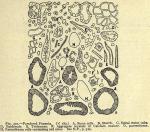B.—Alphabetical List of Drug Powders with Synopsis of Essential Microscopical Elements.
(Part IV. Powdered Drugs.)
(For more detailed description of the microscopical elements see U.S.P.)
(Numbers Refer to No. of Drug in Part II.)
146. Aconite
Powder.—Grayish-brown; starch grains, nearly spherical, simple or 2 to 5 compound (3 to 15 µ in diam.); stone cells, large, tabular, irregular, or elongated to fibers; yellowish-brown cork fragments, few; tracheae, spiral, reticulate or with bordered pits; parenchyma, relatively thick-walled, filled with starch.
341. Althaea
Powder.—White or light yellow; starch grains, numerous (5 to 20 µ in diam.), calcium oxalate crystals in rosette aggregates (15 to 35 µ in diam.); bast fibers in groups, sometimes not strongly lignified, tracheae scalariform or with bordered pits; numerous parenchyma fragments with large mucilage cells.
381. Anisum
Powder.—Yellowish-brown, fragments of pericarp showing portions of yellow oil reservoirs numerous; small tracheae accompanied by sclerenchyma fibers; endosperm cells filled with aleurone (about 6 µ in diam.), each containing a rosette crystal of calcium oxalate (about 2 µ in diam.); 1-celled hairs up to 2000 µ long, having slight projections on the surface; the endocarp is characteristic.
565. Arnica
Powder.—Yellowish-brown, pappus consists of multicellular axis with unicellular branches; non-glandular hairs 1- to 6-celled, glandular hairs of three kinds, with unicellular stalk and unicellular head; a 4-celled stalk and unicellular head, or a 10-celled stalk of a double row of cells with a 2-celled head; pollen grains numerous, spherical (25 to 35 µ in diam.)
42. Amylum

 Powder.—White, starch grains, polygonal, rounded or spherical (3 to 35 µ in diam.) with central cleft 3 to 5 rayed.
Powder.—White, starch grains, polygonal, rounded or spherical (3 to 35 µ in diam.) with central cleft 3 to 5 rayed.
12. Aspidium
Powder.—Greenish or brown; starch grains, numerous, oval or oblong (5 to 15 µ in diam.) in characteristic clumps; fragments of parenchyma sclerenchyma fibers and tracheids numerous; and characteristic brown fragments of the endodermis.
447. Aspidosperma
Powder.—Reddish-brown,; starch grains, spherical, ovoid or plano-convex (3 to 25 µ in diam.); bast fibers, long accompanied by crystal fibers; stone cells in large groups; cork cells sometimes lignified; calcium oxalate in prisms or pyramids (8 to 30 µ long).
Powder.—Yellowish to light brown, consists mostly of parenchyma with occasional membrane crystals of calcium oxalate (4 to 30 µ long); tracheae, few small, spiral or with simple pores.
504. Belladonna
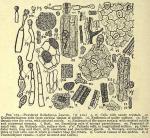 Powder.—Green, consists mostly of irregular leaf fragments; calcium oxalate small in small aggregates or wedge-shaped micro-crystals; hairs, few, the non-glandular 2 to 5 cells, the glandular with 1- to 3-celled stalks and heads one to many celled; tracheae annular, spiral, reticulate or with bordered pits; few long thin-walled bast fibers and few pollen grains. (See Fig. 279.)
Powder.—Green, consists mostly of irregular leaf fragments; calcium oxalate small in small aggregates or wedge-shaped micro-crystals; hairs, few, the non-glandular 2 to 5 cells, the glandular with 1- to 3-celled stalks and heads one to many celled; tracheae annular, spiral, reticulate or with bordered pits; few long thin-walled bast fibers and few pollen grains. (See Fig. 279.)
503. Belladonnae radix
Powder.—Light brown; starch grains, numerous, spherical, polygonal or plano-convex (3 to 30 µ in diam.) 2 to 8 or more compound; micro-crystals of calcium oxalate numerous (3 to 10 µ); cork cells, few; tracheae, few and large, usually associated with wood fibers; long bast fibers from stem bases are often present.
274. Buchu
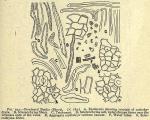 Powder.—Pale green, consists mostly of parenchyma, often containing sphaerocrystals of inulin (25 to 40 µ in diam.) and numerous globules short and unicellular; aggregate crystals of calcium oxalate (15 to 25 µ in diam.); tracheids and bast fibers, few. (See Fig. 294.)
Powder.—Pale green, consists mostly of parenchyma, often containing sphaerocrystals of inulin (25 to 40 µ in diam.) and numerous globules short and unicellular; aggregate crystals of calcium oxalate (15 to 25 µ in diam.); tracheids and bast fibers, few. (See Fig. 294.)
156. Calumba
Powder.—Yellowish to greenish-brown; starch grains, numerous (8 to 85 µ in diam.) few 2 to 3 compound, ovoid, ellipsoidal or irregular usually with excentral hilum; stone cells, few, usually containing one or more prismatic crystals of calcium oxalate, sometimes having micro-crystals; tracheae, few, reticulate or with bordered pits; occasionally, wood-fibers with long, oblique, slit-like pits; cork cells, yellow in regular radial rows and tangentially stretched.
112. Cannabis
Powder.—Dark green, consists of fragments of leaves, and bracts showing yellowish lacticiferous vessels, rosette aggregates of calcium oxalate (6 to 30 µ in diam.), and fragments of fruits and stems; non-glandular hairs, unicellular, pointed, usually containing some calcium carbonate which gives a strong effervescence with dilute HCl; glandular hairs, short with 1-celled stalk, or long multicellular, the head consisting of 8 to 16 cells; palisade-like, thick-walled cells from the fruits; tissues of embryo and endosperm with numerous aleurone grains (5 to µ in diam.) and oil globules.
Cantharis (See Animal Products)
Powder.—Grayish-brown, showing conspicuous shining green particles and numerous long, pointed hairs.
516. Capsicum
Powder.—Yellowish-brown to brownish-red, cells of epidermis of uniform size and regular arrangement; parenchyma containing numerous reddish oil globules, and chromoplasts; stone cells of endocarp with yellowish wavy, moderately thickened porous walls, those of the seed coat, yellowish, irregular, strongly thickened and much more strongly lignified than those of the endocarp.
82. Cardamomi Semen
Powder.—Greenish-brown, fragments of seed with dark brown stone cells (20 µ in diam.); polygonal in surface view; cells of endosperm and perisperm containing compound starch grains (1 to 4 µ in diam.); a few small tracheae may be present.
385. Carum
Powder.—Yellowish-brown; fragments of pericarp with light yellow oil ducts; tracheae often accompanied by sclerenchyma fibers which are slightly lignified and have oblique pits; endosperm cells contain aleurone grains which usually include a rosette of calcium oxalate about 1 µ in diam.
371. Caryophyllus
Powder.—Dark brown to reddish-brown; thin-walled parenchyma showing large oil reservoirs; a few small spiral tracheae and thick-walled spindle-shaped bast fibers, rosettes of calcium oxalate (2 to 15 µ in diam.); pollen grains (15 to 25 µ in diam.).
334. Cascara Sagrada
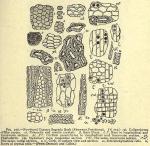 Powder.—Light or dark brown; bast fibers, usually in groups accompanied by crystal fibers; thick-walled stone cells in large groups; parenchyma and medullary ray cells have numerous nearly spherical starch grains (3 to 8 µ in diam.); calcium oxalate in prisms or rosettes (8 to 20 µ in diam.); reddish-brown cork fragments. (See Fig. 276.)
Powder.—Light or dark brown; bast fibers, usually in groups accompanied by crystal fibers; thick-walled stone cells in large groups; parenchyma and medullary ray cells have numerous nearly spherical starch grains (3 to 8 µ in diam.); calcium oxalate in prisms or rosettes (8 to 20 µ in diam.); reddish-brown cork fragments. (See Fig. 276.)
133. Cimicifuga
Powder.—Light or dark brown; starch grains, numerous, simple or compound, spherical or polygonal (2 to 15 µ in diam.); tracheae, mostly with bordered pits and usually associated with lignified wood fibers; yellowish-brown fragments of epidermis.
532. Cinchona
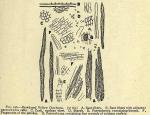 Powder.—Reddish-brown, bast fibers, large spindle-shaped (300 to 1500 µ long) often showing lamellated walls; starch grains, simple or 2 to 5 compound, nearly spherical (3 to 12 µ in diam.); calcium oxalate in wedge-shaped micro-crystals; reddish-brown fragments of cork. (See Fig. 296.)
Powder.—Reddish-brown, bast fibers, large spindle-shaped (300 to 1500 µ long) often showing lamellated walls; starch grains, simple or 2 to 5 compound, nearly spherical (3 to 12 µ in diam.); calcium oxalate in wedge-shaped micro-crystals; reddish-brown fragments of cork. (See Fig. 296.)
532. Cinchona rubra
Powder.—Light brown to brown; elements similar to those of Cinchona, but starch grains are usually fewer and smaller.
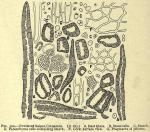 Powder.—Yellowish or reddish-brown; starch grains simple or compound, ellipsoidal or polygonal (3 to 20 µ in diam.); stone cells, irregular colorless or filled with a reddish-brown amorphous substance; bast fibers having thick slightly lignified walls, single or in groups (300 to 1500 µ long); reddish-brown cork fragments. (See Fig. 300.)
Powder.—Yellowish or reddish-brown; starch grains simple or compound, ellipsoidal or polygonal (3 to 20 µ in diam.); stone cells, irregular colorless or filled with a reddish-brown amorphous substance; bast fibers having thick slightly lignified walls, single or in groups (300 to 1500 µ long); reddish-brown cork fragments. (See Fig. 300.)
Powder.—Light or yellowish-brown; starch grains simple or compound, ellipsoidal or polygonal (3 to 20 µ in diam.); stone cells, numerous, irregular, colorless or containing reddish-brown amorphous substance; bast fibers, with thick, slightly lignified walls, spindle-shaped (300 to 1000 µ long). Calcium oxalate raphides (5 to 10 µ long) sometimes present.
68. Colchici Cormus
Powder.—Light to grayish-brown; starch grains numerous, simple or 2 to 6 compound, spherical or polygonal (3 to 30 µ in diam.); few spiral or scalariform tracheae; few fragments of reddish-brown epidermis.
69. Colchici Semen
Powder.—Light brown; parenchyma of endosperm thick-walled with simple pits and containing aleurone grains (3 to 15 µ in diam.) and oil globules; cells of seed coat somewhat collapsed, having thin reddish-brown walls; and a few small ellipsoidal starch grains (5 to 16 µ in diam.).
544. Colocynthidis Pulpa
Powder.—Yellowish-white or buff; consists chiefly of parenchyma cells usually in fragments; tracheae only occasional; from the seed coats few stone cells which are nearly isodiametric or irregular; few oil globules and aleurone grains.
386. Coriandrum
Powder.—Light brown; fragments of endosperm, filled with aleurone grains usually containing aggregates of calcium oxalate, and oil globules; sclerenchyma fibers, yellowish thick-walled, irregularly curved; few fragments of yellow oil reservoirs, and polygonal epidermis; calcium oxalate aggregates (3 to 10 µ in diam.) may be separated from the aleurone grains.
368. Eucalyptus
Powder.—Green; epidermis, thick-walled and strongly cuticularized: palisade, very numerous, 3 to 4 rows deep, in which occur large oil reservoirs containing yellowish contents. Calcium oxalate of rosettes or mono-clinic prisms (15 to 30 µ in diam.), in the spongy parenchyma are vascular tissues and few slightly lignified bast fibers.
382. Foeniculum
Powder.—Yellowish-brown; endosperm cells filled with aleurone grains each with a rosette of calcium oxalate (about 2 µ in diam.); yellowish-brown fragments of oil reservoirs; sclerenchyma fibers few, strongly lignified; spiral or annular tracheae, few; parenchyma cells, numerous; sometimes with thickened walls.
333. Frangula
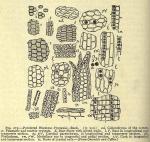 Powder.—Yellowish-brown; stone cells are absent, otherwise the elements are almost identical with those of Cascara Sagrada (see page 295). Frangula gives a deeper orange color than does cascara when treated with alkalies.
Powder.—Yellowish-brown; stone cells are absent, otherwise the elements are almost identical with those of Cascara Sagrada (see page 295). Frangula gives a deeper orange color than does cascara when treated with alkalies.
105. Galla
Powder.—Brownish-gray; starch-bearing parenchyma cells numerous; starch spherical to polygonal (11 to 35 µ in diam.); stone cells few, variable (25 to 250 µ long); tracheae spiral or reticulate.
438. Gelsemium
Powder.—Dark yellow; tracheae, spiral and with bordered pits associated with long narrow fiber-tracheids; bast fibers, long and narrow; starch grains, spherical (4 to 8 µ in diam.); calcium oxalate in monoclinic prisms (15 to 30 µ long); few very thick-walled groups of stone cells.
441. Gentiana
Powder.—Light brown or yellowish-brown, consisting mostly of parenchyma cells varying much in size and form; tracheae spiral, scalariform or reticulate; yellowish-brown cork.
230. Glycyrrhiza
Powder.—Brownish-yellow to pale yellow; starch grains oval or elliptical (3 to 25 µ in diam.); tracheae with bordered pits associated with wood fibers, numerous; bast fibers, numerous, very long and usually in groups accompanied by crystal fibers, containing prisms of calcium oxalate (2 to 25 µ in diam.); fragments of reddish-brown cork occur in Spanish Licorice.
366. Granatum
Powder.—Yellowish-brown to dark brown; crystals of calcium oxalate in aggregate prisms or crystal fibers (10 to 20 µ in diam.); starch grains, spherical to polygonal, simple or compound (2 to 10 µ in diam.); cork fragments, whitish; stone cells, usually occur singly and are strongly lamellated (40 to 200 µ long).
576. Grindelia
Powder.—Yellowish-brown; tracheae, annular spiral reticulate, or with bordered pits, associated with narrow wood fibers; leaf epidermis characteristic, showing large colorless multicellular glandular hairs; pollen grains, spherical spinose (about 35 µ in diam.).
329. Guarana
Powder.—Pinkish-brown; irregular masses of parenchyma and altered starch grains; starch grains, spherical to polygonal (10 to 25 µ in diam.); few elongated, yellowish, thick-walled sclerenchyma cells, which are usually not lignified.
134. Hydrastis
Powder.—Yellowish-brown; starch numerous, usually simple, nearly spherical (2 to 15 µ in diam.); vascular tissues usually associated with starch-bearing parenchyma; tracheae spiral, reticulate or with bordered pits; few thin-walled wood fibers; and occasional fragments reddish-brown cork.
509. Hyoscyamus
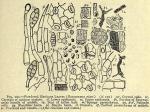 Powder.—Grayish-green; calcium oxalate crystals in 4- to 6-sided prisms (15 to 25 µ long), in spherical or rosette aggregates (about 20 µ in diam.) or in wedgeshaped micro-crystals; non-glandular hairs 2 to 10 cells long; glandular hairs with stalk I to 4 cells long and 1 to many celled head; stomata broadly elliptical about 30 µ long, with 3 to 4 neighboring cells; tracheae spiral reticulate or with bordered pits and associated with few fibers; pollen grains about 40 µ in diam., nearly smooth. (See Fig. 280.)
Powder.—Grayish-green; calcium oxalate crystals in 4- to 6-sided prisms (15 to 25 µ long), in spherical or rosette aggregates (about 20 µ in diam.) or in wedgeshaped micro-crystals; non-glandular hairs 2 to 10 cells long; glandular hairs with stalk I to 4 cells long and 1 to many celled head; stomata broadly elliptical about 30 µ long, with 3 to 4 neighboring cells; tracheae spiral reticulate or with bordered pits and associated with few fibers; pollen grains about 40 µ in diam., nearly smooth. (See Fig. 280.)
530. Ipecacuanha
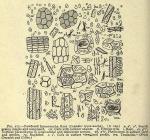
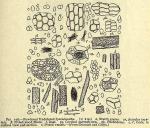 Powder.—Light brown; starch grains, numerous, simple 2 to 6 or more compound, spherical or polygonal (2 to 18 µ in diam.); calcium oxalate raphides (15 to 40 µ long) few; tracheids numerous; occasional stone cells from stem bases (30 to 40 µ long). (See Fig, 277.)
Powder.—Light brown; starch grains, numerous, simple 2 to 6 or more compound, spherical or polygonal (2 to 18 µ in diam.); calcium oxalate raphides (15 to 40 µ long) few; tracheids numerous; occasional stone cells from stem bases (30 to 40 µ long). (See Fig, 277.)
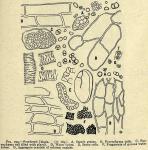 460. Jalapa
460. Jalapa
Powder.—Light brown; starch grains, numerous, simple or 2 to 4 compound ellipsoidal to ovoid (4 to 35 µ in diam.); often swollen and somewhat altered; calcium oxalate in rosettes (10 to 40 µ in diam.); tracheae with simple or bordered pits; laticiferous vessels containing yellowish-brown masses. (See Fig. 299.)
264. Linum
Powder.—Lemon yellow to light brown; the seed coat has tabular pigment cells, filled with reddish-brown insoluble substance; stone cells elongated and yellowish; oil globules numerous; aleurone grains, numerous (2 to 20 µ in diam.).
552. Lobelia
Powder.—Dark green; cells of seed coat more or less polygonal, walls thick and yellowish; few non-glandular hairs (30 to 60 µ long); tracheae annular, spiral or reticulate, accompanied by narrow thin-walled wood fibers; leaf epidermis with elliptical stomata about 25 µ long and with 3 to 4 neighboring cells; pollen grains, nearly spherical about 25 µ in diam.
18. Lycopodium
The spores are spherical tetrahedrons (25 to 40 µ in diam.) with the outer walls extended into irregular projections.
599. Matricaria
Powder.—Yellowish to yellowish-green; pollen grains numerous, spinose, varying from nearly spherical to triangular (about 20 µ in diam.); glandular hairs from the corolla, and cells of the anthers are characteristic; few sclerenchyma fibers.
473. Mentha Piperita
Powder.—Dark green; non-glandular hairs 1 to 8-celled; glandular hairs with stalks 1 or 3-celled and 1 to 8-celled heads; pollen grains nearly spherical, smooth (about 30 µ in diam.); tracheae, spiral or with simple or bordered pits; thin-walled sclerenchyma fibers, few.
474. Mentha Viridis
Powder.—Similar in structure to Mentha Piperita.
365. Mezereum
Powder.—Light grayish-brown; numerous long bast fibers (400 to 3000 µ long) somewhat uneven and bent, non-lignified; cork cells yellowish-brown; starch grains, few, simple or 2 to 4 compound (3 to 15 µ in diam.).
154. Myristica
Powder.—Dark reddish-brown; perisperm of thin-walled parenchyma cells in which are large oil reservoirs; endosperm of parenchyma filled with starch and aleurone grains; starch, simple or compound, spherical to polygonal (3 to 20 µ in diam.); few small spiral tracheae; oil globules numerous.
294. Myrrha
Powder.—Yellowish-brown; mounted in fixed oil shows angular fragments; when cleared and stained in chloral hydrate iodine a few spherical or irregular starch grains (10 to 35 µ in diam.) may appear; when tested with phloroglucin may show fragments of sclerenchyma fibers or stone cells.
435. Nux vomica
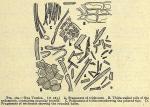 Powder.—Light gray; endosperm cells thick-walled, containing oil globules and aleurone grains; numerous non-glandular, lignified hairs having pitted walls; cells of adhering fruit pulp may show few small spherical starch grains. (See Fig. 302.)
Powder.—Light gray; endosperm cells thick-walled, containing oil globules and aleurone grains; numerous non-glandular, lignified hairs having pitted walls; cells of adhering fruit pulp may show few small spherical starch grains. (See Fig. 302.)
180. Opii Pulvis
Powder.—Light brown; consists of irregular granular fragments; epidermis of poppy capsule 4 to 5-sided or elongated, thick-walled and lignified; fragments of poppy leaves and rumex fruits.
548. Pepo
Powder.—Whitish or yellowish; outer epidermis palisade-like, cells up to 1 mm. long; stone cells variable in size and thickness of walls up to 75 µ long; parenchyma cells with peculiar reticulate markings or rather thick-walled and somewhat
185. Sanguinaria
Powder.—Brownish-red; starch grains, numerous, (3 to 20 µ diam.) spherical to ovoid; simple or 2 to 3 compound; latex tissue fragments with reddish-brown masses; tracheae with slit-like pits few,
239. Santalum Rubrum
Powder.—Brownish-red; wood fibers numerous, walls thick, yellowish, up to 800 µ long; tracheae, few with simple or bordered pits; crystal fibers with prisms of calcium oxalate (10 to 20 µ in diam.).
58. Sarsaparilla
Powder.—Grayish-brown; starch grains, spherical to nearly tetrahedral, simple or 2 to 5 compound (3 to 25 µ in diam.); raphides of calcium oxalate (6 to 30 µ long); tracheae scalariform, reticulate or with simple or bordered pits, often associated with thin-walled sclerenchyma fibers; cells of hypoderm and endoderm yellowish, up to 500 µ long.
170. Sassafras
Powder.—Light reddish-brown; starch grains, spherical to polygonal, simple or 2 to 4 compound (3 to 20 µ in diam.); bast fibers, spindle-shaped or irregular (150 to 400 µ long and 25 µ broad) with very thick walls; numerous parenchyma cells, many containing yellowish-red masses of tannin; few brownish-red fragments of cork.
462a. Scammonii Radix
Powder.—Grayish-brown; starch grains, simple or 2 to 4 compound (3 to 18 µ in diam.); calcium oxalate in prisms (10 to 45 µ long); tracheae reticulate or with simple or bordered pits and usually associated with wood fibers; stone cells variable in form (40 to 125 µ long); few cork cells which are often lignified; fragments of phloem showing yellowish-brown resin cells.
67. Scilla
Powder.—Light yellow; raphides of calcium oxalate (750 to 1000 µ long); parenchyma cells large, thin-walled, colorless; tracheae spiral or reticulate; occasionally a few nearly spherical starch grains occur.
302. Senega
Powder.—Yellowish-gray to brown; wood fibers non-lignified (175 to 250 µ long); fragments of thin-walled parenchyma containing oil globules; tracheae with simple or bordered pits; numerous medullary ray cells with large simple pits.
240. Senna
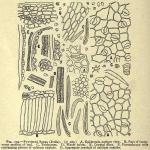 Powder.—Light green (Alexandria Senna) or slightly darker green (India Senna); stomata broadly elliptical (about 20 µ in diam.) crystal fibers; calcium oxalate in rosettes (about 10 µ in diam.) or 4 to 6-sided prisms about 15 µ long); nonglandular hairs 1-celled, often curved, thick-walled and rough up to 350 µ long. In India Senna the hairs are relatively fewer. (See Fig. 295.)
Powder.—Light green (Alexandria Senna) or slightly darker green (India Senna); stomata broadly elliptical (about 20 µ in diam.) crystal fibers; calcium oxalate in rosettes (about 10 µ in diam.) or 4 to 6-sided prisms about 15 µ long); nonglandular hairs 1-celled, often curved, thick-walled and rough up to 350 µ long. In India Senna the hairs are relatively fewer. (See Fig. 295.)
118. Serpentaria
Powder.—Grayish-brown; starch grains spherical to plano-convex (3 to 14 µ in diam.), simple or 2 to 4 compound; trachea) annular, spiral or reticulate; short wood fibers; small amount of cork; numerous lignified parenchyma pith cells; few non-glandular hairs from stem may be present.
188. Sinapis Alba
Powder.—Light yellow to brownish-yellow; parenchyma cells contain aleurone and oil; fragments of seed coats nearly colorless composed of small stone cells and large epidermal cells, the outer walls being mucilaginous; occasionally few small starch grains are present.
189. Sinapis Nigra
Powder.—Light brown to greenish-brown; thin-walled parenchyma of embryo contains alleurone grains and oil; fragments of seed coats composed of small yellowish stone cells with dark lumen; and large mucilaginous cells of epidermis often associated with the very large sub-epidermal cells.
439. Spigelia
Powder.—Grayish-brown; starch grains nearly spherical (2 to 6 µ in diam.); tracheae and tracheids conspicuous; few long slender bast fibers; fragments of reddish-brown epidermis and brownish cork.
304. Stillingia
Powder.—Pinkish or reddish-brown; starch grains variable in form, mostly simple (5 to 35 µ in diam.); tracheae with simple pits, usually associated with wood fibers; bast fibers long, narrow, thick-walled; reddish-brown cork; rosettes of calcium oxalate up to 35 µ in diam; somewhat tabular reddish-brown secretion cells.
507. Stramonium
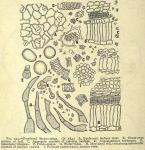 Powder.—Brownish-green; stomata elliptical about 25 µ long, usually with 3 neighboring cells; calcium oxalate in numerous rosettes (10 to 20 µ in diam.) in prisms or wedge-shape micro-crystals; non-glandular hairs with 1 to 2-celled stalks and 2 to 4-celled heads; spiral or annular tracheae; stems have large tracheae with annular and spiral thickening or with bordered pits usually associated with wood parenchyma and occasional wood fibers; long collenchymatous cells are often present, (See Fig. 293.)
Powder.—Brownish-green; stomata elliptical about 25 µ long, usually with 3 neighboring cells; calcium oxalate in numerous rosettes (10 to 20 µ in diam.) in prisms or wedge-shape micro-crystals; non-glandular hairs with 1 to 2-celled stalks and 2 to 4-celled heads; spiral or annular tracheae; stems have large tracheae with annular and spiral thickening or with bordered pits usually associated with wood parenchyma and occasional wood fibers; long collenchymatous cells are often present, (See Fig. 293.)
451. Strophanthus
Powder.—Grayish to dark-brown; mostly composed of thin-walled parenchyma cells; many of which are colored greenish upon addition of H2SO4; numerous fragments of long thin-walled hairs (relatively fewer in S. hispidus); numerous oil globules.
400. Sumbul
Powder.—Grayish-brown; numerous large tracheae which are mostly reticulate; long narrow collapsed fragments of phloem; few fragments of parenchyma containing starch grains (3 to 12 µ in diam.); numerous nearly colorless or yellowish to reddish-brown irregular fragments.
553. Taraxacum
Powder.—Light brown; parenchyma cells large; thin-walled containing masses of inulin; fragments of yellowish latex vessels; reticulate trachea; and sclerenchymatous fibers.
256. Tragacantha
Powder.—Whitish; irregular fragments showing lamellated mucilaginous walls and few starch grains nearly spherical, simple or 2 to 3 compound (3 to 17 µ in diam.).
37. Triticum
Powder.—Yellowish; tracheae annular, spiral or with simple pits and associated with long narrow sclerenchymatous fibers; epidermal cells rectangular strongly lignified with numerous transverse pits; numerous fragments of rectangular thinwalled parenchyma.
109. Ulmus
Powder.—Light brown; bast fibers numerous very long and slightly lignified, often associated with crystal fibers; calcium oxalate in prisms (10 to 25 µ in diam.); starch grains, mostly simple, nearly spherical (about 3 or µ in diam. or up to 25 µ) fragments of large mucilage cells.
411. Uva Ursi
Powder.—Olive green; epidermal cells polygonal; stomata, broadly elliptical about 25 µ long with 5 to 8 adjacent cells; tracheae mostly spiral, often associated with sclerenchyma and crystal fibers; prisms of calcium oxalate (6 to 15 µ in diam.).
543. Valeriana
Powder.—Light brown or grayish-brown; starch grains spherical to polygonal, simple or 2 to 4 compound, (3 to 20 µ in diam.); tracheae reticulate or with simple or bordered pits often accompanied by sclerenchyma fibers; fragments of epidermis with root hairs and brownish cork.
60. Veratrum Viride
Powder.—Grayish-brown to dark brown; starch grains, spherical or ellipsoidal simple or 2 to 3 compound (3 to 20 µ in diam.); calcium oxalate raphides (15 to 150 µ long); tracheae scalariform or reticulate and usually associated with narrow sclerenchyma fibers; fragments of reddish-brown cork.
541. Viburnum Prunifolium
Powder.—Dark brown; stone cells, numerous, large and thick-walled: bast fibers few, with occasional crystal fibers; calcium oxalate in prisms or rosettes (15 to 35 µ in diam.).
270. Xanthoxylum
Powder.—Grayish-brown; cork cells nearly colorless and lignified; parenchyma containing small starch grains, oil globules or calcium oxalate; stone cells in small groups; few bast fibers,
78. Zingiber
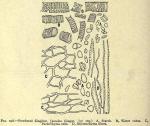 Powder.—Light yellow to brown; parenchyma cell large and thin-walled filled with starch; starch grains ovate to elliptical (15 to 60 µ long); sclerenchyma fibers long and thin-walled; tracheae reticulate or scalariform; yellowish or brown oil and resin cells; brownish flattened cork cells, which are absent in Jamaica Ginger. (See Fig. 298.)
Powder.—Light yellow to brown; parenchyma cell large and thin-walled filled with starch; starch grains ovate to elliptical (15 to 60 µ long); sclerenchyma fibers long and thin-walled; tracheae reticulate or scalariform; yellowish or brown oil and resin cells; brownish flattened cork cells, which are absent in Jamaica Ginger. (See Fig. 298.)

